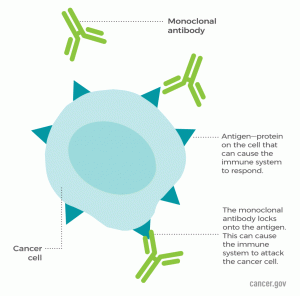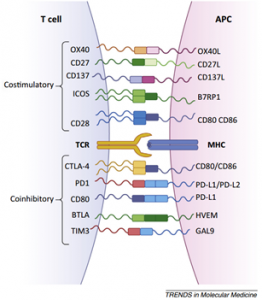40 2.2: Suppression and Activation of the T cell Response
T cells are remarkable cells of the immune system. They can precisely detect and kill cancer cells. Early studies of the role T cells played against cancer established that when immunized against a cancer antigen, T cells can target that specific antigen. Therefore, the goal is to find antigens unique to cancerous cells and encourage T cells to target those antigens.
Unique cancer antigens can be discovered by the process of whole genome sequencing. The cancer genome can be compared to our own healthy genome to find unique molecules. There are two sets of main cancer targeting antigens:
- Neo-antigens: antigens which do not exist normally on human cells.
- Tumor associated antigens (TAAs): normal human antigens that are expressed on cancer cells at the wrong time or place
For example, TAA’s can come from new point mutations such as cancer testis antigen. This antigen is only normally found in the testis but melanoma is known to express it. Some genes are highly over expressed in cancer, which as the gene Wilm’s 1 in many types of cancer. Transcriptional abnormalities can also occur which create new proteins. For example, in Burkitts lymphoma the c-Myc can come under the control of the immunoglobulin promoter, causing serious overexpression of this oncogene. These abnormalities can be targeted by T cells.
CD4 T cells and CD8 T cells play different roles in cancer recognition.
CD4 T cells play a multifaceted role in tumor immunity. They can directly recognize tumors expressing MHC class 2 and therefore see tumor antigens. CD4 TH1 cells promote anti-tumor immunity by producing IFN-g. This can contribute to killing cancer cells. CD4 TH2 cells may have anti-angiogenic properties that prevent tumor growth by limiting access to the material cells need. TREGs are immunosuppressive CD4 T cells which prevent tumor immunity and promote tumor growth. They are upregulated in the tumor microenvironment.
CD8 T cells can be primed to recognize TAAs by dendritic cells. They can also recognize tumor antigens by MHC class 1 antigen presentation from tumor cells. The surface receptor NKG2D can be activated and direct lysis of tumor cells can occur through granzyme and perforin release by CD8 T cells.
Monoclonal antibodies (mAbs) can be used to deplete particular cells in vivo by having them
recognize receptors on the surface of cancer cells or T cells. The variable part of the antibody binds to the specific antigen or receptor, and the constant part activates complement mediated lysis or recruits cytotoxic cells to kill the cancer cell. If a monoclonal antibody binds to a receptor on a T cell, it can selectively activate or repress activity through that receptor depending on what it does. This is called an agonist or antagonist mAb.

Figure 4: Monoclonal antibodies in action. https://www.cancer.gov/about-cancer/treatment/types/immunotherapy/monoclonal-antibodies
Definitions
- Agonist: a chemical that binds to a receptor and activates the receptor to produce a biological responseAntagonist: blocks the action of the agonist
For example, TREGs are immunosuppressive CD4 T cells which prevent tumor immunity and promote tumor growth. Therefore, blocking a receptor that activates TREGs would be beneficial to targeting cancer. CD25 is highly expressed on TREGs and can be targeted by anti-CD25 mAbs. This depleted TREGs however it can have side effects including autoimmune problems.
Checkpoint blockade can be used to upregulate and promote the activity of T cells. T cells have activating and suppressing ligands so that their activity can be controlled in the periphery.
Activating ligands are called “co-stimulatory”. They make T cell activity more likely are follow the presentation of antigen to T cells. Suppressive ligands are called “co-inhibitory”, and attenuate activation.

Figure 5: Co-stimulatory and co-inhibitory molecules in T cell activation and repression. Obtained from: https://www.frontiersin.org/articles/10.3389/fphar.2018.00642/full.
Blocking monoclonal antibodies that target the co-inhibitory molecules prevent suppression of the immune response. There are immunotherapy drugs that use this logic, for example, monoclonal antibodies that are antagonists for CTLA-4, PL-1, and TIM3. Co-stimulatory ligands can be targeted with agonists to promote activation. For example, agonist monoclonal antibodies against CD28, CD27, and OX40.
These amazing therapies serve one purpose: to carefully tip the immunological balance in the right direction. To promote an anti-cancer response and prevent suppression of negative regulators of anti-cancer responses.
In subsequent units, you will learn about successes, limitations, and applications of these immunological tools.
Test your knowledge:
